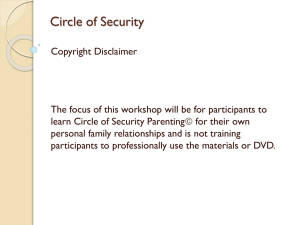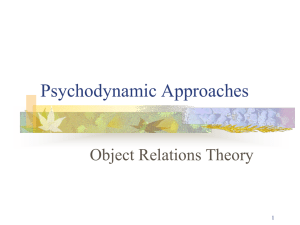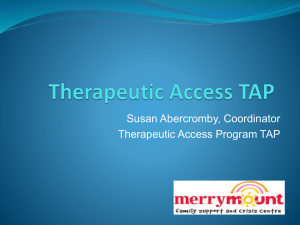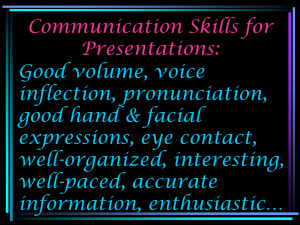the presentation in English (PPT 84 Ko)
advertisement
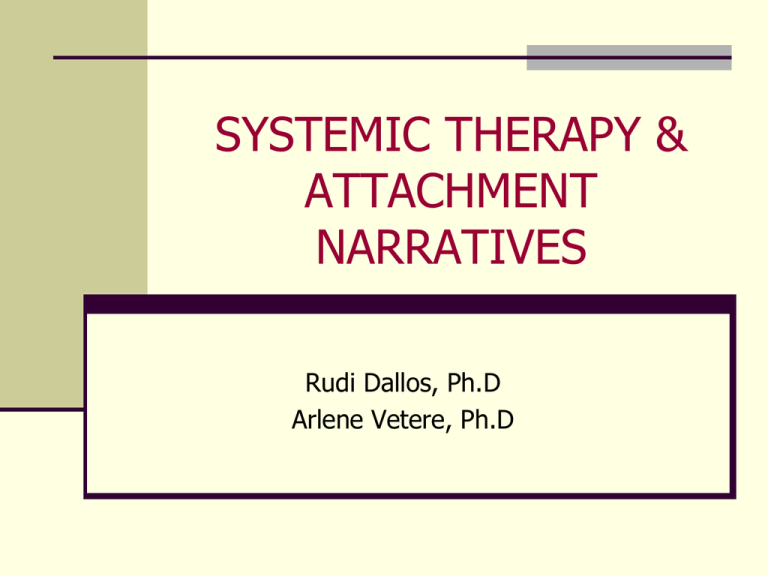
SYSTEMIC THERAPY & ATTACHMENT NARRATIVES Rudi Dallos, Ph.D Arlene Vetere, Ph.D Dynamic Systems “Many of the most intense emotions arise during the formation, the maintenance, the disruption and the renewal of attachment relationships. The formation of a bond is described as falling in love, maintaining a bond as loving someone, and losing a partner as grieving over someone. Similarly, threat of loss arouses anxiety, and actual loss gives rise to sorrow; whilst each of these situations is likely to arouse anger. The unchallenged maintenance of a bond is experienced as a source of security and the renewal of a bond as source of joy.” (Bowlby, 1980) ATTACHMENT NARRATIVE THERAPY Creating a secure base Exploring Narratives and Attachments within a Systemic Framework Considering Alternatives Future and Maintaining the therapeutic base THEORETICAL PERSPECTIVES ATTACHMENT NARRRATIVE THERAPY Why the 3 perspectives need each other? 1. 2. 3. Social Constructionist - Narrative practice Attachment Theory Systemic Theory and practice Persons and families in social/cultural contexts THE NARRATIVE TURN IN ATTACHMENT THEORY Internal working models – attachment as a set of belief, expectations, stories we have about ourselves and others Narrative approaches - move to assessing attachment through the content and structure of the stories people tell about their lives Narrative – ability to tell coherent stories about our lives is shaped by our attachment experiences in families Internal Working Models Beliefs and expectations about One’s own and other people’s behaviour Views of the SELF – How loveable, worthy and acceptable am I? How available and interested are others in me, and in caring for and looking after me? These guide our actions, thoughts and feelings – how we try to keep ourselves safe, close to and loved by others Internal Working Models SECURE: able to use feelings and cognitions to make sense of events INSECURE: AVOIDANT: Shut down and deny feelings, display of distress is expected to annoy the caregiver so engage in pretending - put on false front – distrust of feelings AMBIVALENT: Expect carer to be inconsistent, not able to predict their availability or verbal promises. Develop clingy and coercive strategies to secure attention and caring - distrust of words DISORGANISED: Carer may be confusing, frightening, abusive, child finds it difficult to develop and predict a consistent pattern – distrust of words and feelings ATTACHMENT STYLES AS COMMUNICATIONAL PATTERNS ATTACHMENT AS ‘OPEN’ or ‘CLOSED COMMUNICATION’ IN FAMILIES INSECURE ATTACHMENT INVOLVE ‘ DISTORTIONS’ OF COMMUNICATION - such that we cannot say openly or clearly how we feel and what we need ATTACHMENT STYLES AS A SET OF FAMILY COMMUNICATIONAL RULES SECURE: Expression of feelings met by acknowledgement, reflection and negotiation – semantic and emotional responses DISMISSIVE: Communication of feelings met by injunction to suppress feelings, avoidance, rejection – semantic responses PRE-OCCUPIED: Symmetrical escalating expressions of feelings, mutual accusation, blaming – emotional response Family Patterns INSECURITY can develop from FAMILY patterns Parents may differ in their styles , e.g. mother avoidant/dismissive , father ambivalent/pre-occupied Parents may switch positions MOTHER FATHER Pre-occupied Dismissive CHILD ? CLAIRE Int: ..can you describe your family in terms of relationships ? Claire: It’s very false, its very strange. I mean its changed a lot. When I was younger it was just awful all the time, I don’t like anger now, its like, arguing non stop. It was horrible I would do anything to stop them arguing and anger is like fear. I don’t like anger now, its like an emotion that can’t be controlled and that scares me....But recently everyone’s been really trying but it still seems, it seems really false to me…….. The only thing I ever hear them talking about is me and if I didn’t have this [anorexia] its kind of like, would everything fall apart, at least its keeping them talking. And they won’t argue while I’ve got this because it might make me worse. So um...that’s kind of bought, sort of like, I’m not in control as such but I’ve got more control over the situation that way.’ Int: So if you were upset or distressed or frightened when you were young, who would you go to? Claire: Nobody. I wouldn’t go to anybody. The only time I ever did was once when Mum was at work and I had to sleep in my brother’s room. I can’t remember why, and there was a picture of me and her when we were little, cuddling, and I was only young and I was looking at this picture and I was crying so much because I thought because they’re older than most parents that she was going to die really soon and I went down to Dad and he was like “ Don’t be stupid and go back to bed”, and I had to go back to bed. And after that I didn’t bother going to him. I would just bottle it all up and just not bother’ Implications for Therapy Naming and regulating emotions Standing in the emotional shoes of the other Comforting and self soothing Information processing Transformations in memory systems “Felt security” in a relationship Affect regulation (less reactivity, hyper- arousal & under-arousal) Support seeking Information processing (curiosity, open, more toleration of uncertainty) Communication (meta-communication, disclosing, collaborative, assertive, empathic) ‘Sense of self’ (elaborated, articulated, positive) THERAPY AS SCAFFOLDING: Emotional and cognitive Therapy and scaffolding: Encourage a secure emotional base – stance of acceptance and non- judgement Encourage noticing people’s feelings Offer words, phrases to help identify feelings Offer words and phrases to talk about how others feel Offer words and phrases to help discuss how people comfort each other Offer words, phrases , stories to assist integration of feelings and events Systemic Techniques and Attachment Styles AVOIDANT/DISMISSIVE AMBIVALENT/PRE-OCCUPIED Encouraging expression of feelings Encouraging expression of cognitions Enactment Genograms Role play Life line Empathic Questions Tracking Circularities Internalised Other Interviewing beliefs/ punctuation Mapping Relationships Areas of conflict How conflict is managed Scaling questions Circular questions Shared/family beliefs Caring and comforting REFLECTING TEAMS Attachment Narrative Therapy with Families/Couples Creating a secure base Mapping the context & talk about talk Engaging warmly with each member of the family Reflecting on our relationships in the room –modeling open communication Use of self – therapist reflecting on his/her own experiences Adopting a non-blaming approach - working together vs ‘fixing families’, purpose is not to find fault in the past or present Externalizing Framework Exploring the ‘problem’ - beliefs, feelings, explanations A ‘conservative’ (paradoxical) framework - not pushing for change Access, expand, reprocess emotional experience De-escalating unhelpful patterns Attachment Narrative Therapy with Families/Couples Exploring Narratives and Attachments within a systemic framework Current attachments Gossiping - circular questioning Trans-generational attachment traditions Encouraging sociality/empathy Impact of the problem on the family relationships and vice versa Encouraging awareness of self and others in interaction Attachment Narrative Therapy with Families/Couples Considering Alternatives Contemplating alternative narratives and responses Family experiments: in and outside the therapy room Unique outcomes – exceptions Working ‘within’ and ‘between’: moving between intra and interpersonal narratives Promoting secure bonding interactions Attachment Narrative Therapy with Families/Couples The future and maintaining the therapeutic base Contemplating futures Consolidating change Plans to deal with relapse Considering ways of continuing contact Feelings about separation, ending therapy Exploring Patterns of Comforting When you were upset or frightened as a child – what happened? How did you get to feel better? Who helped you to feel better? How did they do this? What have you learnt from this for your own family? What do you want to do the same? What do you want to do differently? How do people comfort each other in your own family/ relationship? How do you comfort your children? How do they comfort you? Can be done as a family or couple interview or as a one-to-one conversation. Corrective and Replicative Scripts This utilises ideas from John Byng-Hall that families make comparisons across the generations in terms of similarities and differences between how our own parents were with each other and us ( the children) and how this is repeated or altered in the next generation. Importantly it allows us to work in a positive frame with the family in that we can construe the intentions of the parents positively, i.e. they have tried to repeat what was good or correct what they felt was bad about their own experiences. This can then lead to a discussion of whether these attempts have been successful or not, and possibly how they might be altered, strengthened, elaborated etc. What are your thoughts about how similar or different your relationship with each other and your children is to your parent’s ( grandparents’) relationships ? What have you tried to make similar or different to either of these relationships? What do you value vs feel critical about in either of your parent’s relationships Does what you have tried to repeat/change work? Is there anything that you want to alter, strengthen, abandon about what you have been trying to repeat or change? How to Contact Us r.dallos@plymouth.ac.uk a.vetere@surrey.ac.uk



